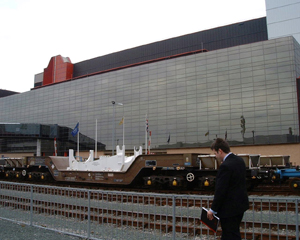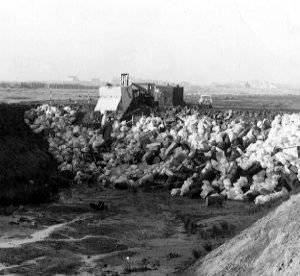
 |
It is useful to
remind everyone of one political reality. Any nation that wishes to be a nuclear
weapons state must have both nuclear reactors and a reprocessing plant such
as Sellafield. The anti-nuclear movement in the UK and abroad is convinced this
strategic factor has helped bankroll the nuclear industry for 70 years.
Latest: May 2022..Final
shutdown for Magnox at Sellafield..
(April 2010 Latest taxpayer payment...It has been announced that the Government
is to give the Nuclear Decommissioning Authority (NDA) £2.8bn for the
next financial year.)
In 2018 the government confirms that fuel reprocessing at the Thermal Oxide
Reprocessing Plant (THORP) wil end in 2018 and then its Magnox Reprocessing
Plant in 2020
Information
2007/8 on inventory of uranium/plutonium held by NDA.
Report
post-Fukushima on alternative to Reprocessing
Reprocessing has become a 'spin word' that puts an improved gloss on the problem of the waste that emerges from nuclear reactors. This 'spent' fuel is a lethal rod of uranium, plutonium and dozens of radioactive isotopes. The act of reprocessing does not destroy any of this cocktail of radiation. It divides and spreads the radiation into several routes: plutonium, uranium, highly radioactive waste, medium level nuclear waste and a lot of low level nuclear waste. In addition the process itself increases the volume of nuclear waste by 'contaminating' buildings, people and the environment. The financial cost of dealing with the legacy of the nuclear industry keeps growing. In 2002 BNFL's annual report showed total nuclear liabilities on BNFL sites (undiscounted) to be £40.5b, up from the previous year's figure of £34.8b. All of which is being left to the taxpayer to deal with. These early figures have gelled in a liability managed by the tacxpayers' NDA as £70 billion by 2012.
The official reason for approving the newest Sellafield reprocessing plant, called THORP were up front contracts to take Japanese nuclear waste and the fact that uranium could be recycled and used to make new nuclear fuel. However the price of raw uranium has plunged from $45 per lb. in 1978 to $10 a lb.by (August 1999). Independent UK government body RAWMAC says: "There is no compelling waste management reasons to reprocess oxide fuel ...at all." However reprocessing is the economic lifeblood for the West Cumbrian communities around Sellafield employing as it does 7,000 people. There is an apparently acceptable alternative to nuclear reprocessing in dry storage of the untouched spent nuclear fuel. This is the route being taken by the USA and Scottish Nuclear(now part of British Energy) wanted to spend £100m each on such dry storage vaults at Torness and Hunterston B. GEC Alstrom was involved in MVDS (dry vaults) for Colorado.
 THORP
was built at a cost of £2.7 billion. It started operating in 1994. Basic
details of the project include: 35 M. frame design building to withtstand seismic
and a 1 in 10,000 years wind; 40M stainless steel roof span; 4200 tonnes carbon
steel and 600 tonnes stainless steel.
THORP
was built at a cost of £2.7 billion. It started operating in 1994. Basic
details of the project include: 35 M. frame design building to withtstand seismic
and a 1 in 10,000 years wind; 40M stainless steel roof span; 4200 tonnes carbon
steel and 600 tonnes stainless steel.
THORP first receipt of fuel 8/8/88.Cost estimate £1.8billion, plus £0.9
billion on support storage ponds etc. Struc Engineers winning the award were
Allott and Lomax/ Architects were BNFL. inlet pond stainless steel lined concrete.
THORP is BNFL's largest investment. There were 5,000 contractors on site during
its construction. Permanent jobs at THORP are supposed to be 1,400. Cost £2.7Billion.
1800 miles of cable, 200 miles pipes.
Historically...Contracts
held for first decade's work (1994-2004)of 7,000tonnes. For its second decade
58% of its capacity is said to be agreed (from nine countries) and 43% for the
third decade. In 2003 BNFL admitted it was to pull out of reprocessing after
failure to win Thorp business left company technically insolvent. A massive
government bail out created a successor to BNFL in the form of NDA. To quote
from anti-nuclear group CORE in 2003: "Now in its tenth year of operation
and plagued by a range of problems since it opened THORP has reprocessed little
over 4000 of the 7000 tonne Baseload and is currently running at least three
years behind schedule. At the current rate THORP might complete the Baseload
and the smaller volume post-Baseload business from British Energy and Germany
by around 2010. Fighting off opposition claims in the early 1990’s that
the plant was a white elephant that would bankrupt BNFL, the company’s
then Chief Executive Neville Chamberlain said that "THORP is already certain
to be a successful project that will underpin BNFL’s profitabity over the
next quarter of a century"
CORE’s spokesperson said; " It is ironic that at the same time as this so-called flagship plant continues to flounder, BNFL has been declared bankrupt. In their haste to get the plant open in the early 1990’s, they deliberately ignored the increasing worldwide trend against reprocessing and the dwindling prospects for new contracts.
THORP throughput continues to be specifically limited by the Nuclear Installations
Inspectorate to around 50% of design throughput. This follows BNFL’s inability
to get its waste vitrification process working to a level where the liquid High
Level Wastes from THORP can be treated. Designed to reprocess over 1000 tonnes
per year, THORP was limited to just 500 tonnes last year. In 2005 THORP is expected
to be handed over to the Nuclear Decommissioning Agency (NDA) along with BNFL’s
other liabilities. Uncertainties about both the German and British Energy post-Baseload
orders may lead the NDA to consider stopping reprocessing at THORP even earlier
than 2010.''
One of the problems of opting for reprocessing, rather than spent fuel storage,
is the creation of a great deal of contaminated material. From rubber gloves
to overalls and parts of plant and machinery. This waste is classified as low
level nuclear waste and is buried at the Drigg nuclear dump two miles south
of Sellafield.(Pictured left) Ironically the security fence surrounding
this waste dump is immediately adjoining a nature reserve. Pictured are the
nuclear waste trenches that were used until the 1980's. Now the low level waste
is compressed and packaged inside steel containers before burial.
In 2017 Sellafield Sites announced the end of reprocessing at THORP...they claimed
it had been a success, stating in 2016: "The end of an era. By the end
of next year Thorp will have honoured all of its contracts and this chapter
of our reprocessing mission will be finished. Our teams will then start the
process of cleaning up the parts of the building that chemically separated the
nuclear fuel. This will take a few years to complete. Thorp’s receipt and
storage ponds and facilities will continue to operate beyond 2018, and will
continue to receive used fuel from EDF Energy’s Advanced Gas-cooled Reactors.
Instead of being reprocessed this fuel will be stored in the ponds pending a
final disposition decision." As usual the eventual nightmare of final disposal
of nuclear waste remains uncertain.....
New Vitrification
plant (VIT) to turn lethal liquid high level waste into glass blocks. VIT 1
official open Michael Heseltine March 1991, feedstock activity 1.7 x10 to power
10 bq per mil. or 460 curies a litre. 4 watts per litre. non-active feeds sugar
and glass! melter at 1050 degree c. form 25 kilos an hour. each stainless steel
drum holds 150 litres. typical surface temp in store 200 degree c. activity
each 300000 curies. store has four vaults..200 tubes per vault expected full
by year 2010. cooling air outlet temp 120 degreec. Radioactive discharges expected;
aerial 6 s pwr year alpha and 3000 MBq per year beta.
Typical of the goodwill spending by BNFL in West Cumbria include: West Cumbria
Development Fund £6.3M, Whitehaven Development Company £0.5M, Westlakes
Science Park £1.5M, others £1.3M.
In 2004 government confirmed that in 2005, it will set up the NDA to look after
UK nuclear waste at Sellafield. the authority will create between 150 and 200
civil service jobs plus more in decommissioning. Government assigned £48
billion for the task. By 2009 the estimated clean-up bill for nuclear power
in the UK had reached £72 billion.
The industry continues generating dangerous High Level active waste and A MAJOR
CONTRACT for the highly-active liquid effluent facility at Sellafield has been
awarded (Sept 2010 )to the HALEF Partnership - a consortium comprising Amec,
Areva and Balfour Beatty. The planned facility will be used to store radioactive
waste arising from nuclear fuel reprocessing operations at the Sellafield site.
The facility will comprise a series of high integrity highly active storage
tanks and associated process equipment housed in a seismically reinforced concrete
building.
Events at Fukushima led to this
report on the alternative to reprocessing...air-cooled dry casks to store
spent nuclear fuel instead of reprocessing. The Economist
magazine reported in 2014 that:Sellafield alone costs £1.7 billion
($2.8 billion) a year, almost as much as the roughly £2 billion spent
subsidising renewable energy in 2013.
Farewell to the cooling towers at Calderhall in 2007